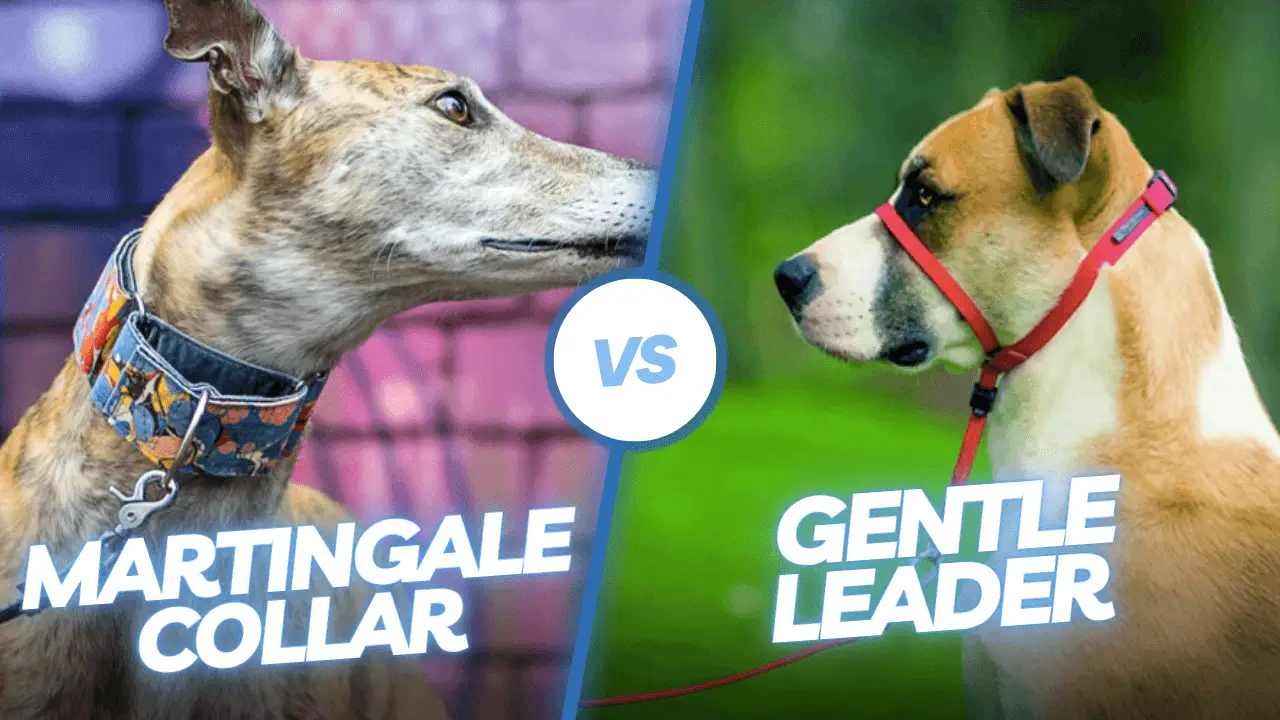Martingale collars and Gentle Leaders are popular dog collars for training and walking. Both collars are designed to prevent dogs from pulling on their leash and provide better control for their owners. However, owners should consider key differences between the two collars when choosing the right one for their dog.
Martingale collars, or limited-slip collars, are designed to prevent dogs from slipping out of their collars. They are made with two loops, one that goes around the dog’s neck and another that tightens when the dog pulls on the leash. This tightening action is meant to discourage pulling and give owners more control over their dog’s movements. Martingale collars are often recommended for dogs with narrow heads, such as Greyhounds and Whippets, as they prevent the collar from slipping off.
Gentle Leaders, on the other hand, are head collars that fit over the dog’s nose and neck. They work by controlling the dog’s head and redirecting their attention when they start to pull on the leash. Gentle Leaders are often recommended for dogs that are strong pullers or tend to lunge at other dogs or people. While some dogs may take time to adjust to the sensation of wearing a Gentle Leader, many owners find that it gives them better control and makes walks more enjoyable for them and their dogs.
Understanding Martingale Collars
Martingale collars are a type of dog collar that provides more control than a typical flat collar to prevent dogs from backing or slipping out. They are also called no-slip or limited-slip collars. The design of the martingale collar includes a flat collar with an additional loop of fabric that tightens when the dog pulls.
Design and Material
Martingale collars are made of different materials, including nylon, leather, and chain. The most common material is nylon, which is lightweight and durable. The collar’s design includes a loop of fabric that tightens when the dog pulls, preventing the dog from slipping out of the collar. The collar’s width and length vary depending on the breed and size of the dog.
Safety and Control
Martingale collars are safer than choke collars because they do not tighten as much as choke collars. The collar’s design allows pressure to be applied evenly around the dog’s neck, preventing injury. The collar also provides more control than a standard collar, making it ideal for dogs that pull or are aggressive.
Training and Behavior Management
Martingale collars are ideal for training and behavior management. They are used to teach dogs not to pull, jump, or be aggressive. The collar’s design allows for more control over the dog’s movements, making it easier to train them. The collar’s tightening action also helps to discourage dogs from pulling or lunging.
Ideal Breeds for Martingale Collars
Martingale collars are ideal for sighthounds and other breeds with narrow heads, such as greyhounds, whippets, and Italian greyhounds. The collar’s design prevents the dog from slipping out of the collar, a common problem for these breeds. The collar’s width and length should be chosen based on the dog’s size and breed.
Pet parents should always supervise their dogs when using a martingale collar. The collar should fit snugly around the dog’s neck without being too tight. The collar’s D-rings should be positioned at the back of the dog’s neck to prevent choking.
Unveiling the Gentle Leader
The Gentle Leader is a head halter designed to help control a dog’s pulling behavior during walks. It is a popular alternative to traditional dog collars and harnesses and is often recommended by trainers and veterinarians for dogs with neck or throat problems.
Design and Material
The Gentle Leader is made of durable nylon material and has two straps that loop around the dog’s neck and muzzle. The neck strap fits high on the dog’s neck, while the muzzle strap sits across the dog’s snout. A metal ring connects the two straps.
One of the key design features of the Gentle Leader is the front clip, which is located on the muzzle strap. This clip allows the leash to be attached to the front of the dog’s head, which helps to redirect the dog’s attention and control his pulling behavior.
Control and Safety
The Gentle Leader works by applying gentle pressure to the dog’s neck and muzzle, which helps to discourage pulling and improve control during walks. The pressure is not harmful or painful and is designed to remind the dog to stay focused and calm gently.
One of the main benefits of the Gentle Leader is that it provides more control than a traditional collar or harness without the risk of choking or injury to the dog’s neck or throat. Because the leash is attached to the front of the dog’s head, it is easier for the handler to guide the dog and prevent him from pulling or lunging.
Training and Behavior Management
The Gentle Leader is often used for training and behavior management, particularly for strong pullers or aggressive dogs. It can be especially helpful for dogs that bark or lunge at other dogs or people during walks.
However, it is important to note that the Gentle Leader is not a substitute for proper training and behavior modification. It should be used with positive reinforcement techniques and consistent training to help the dog learn good walking habits and improve his behavior over time.
The Gentle Leader is a safe and effective tool for controlling a dog’s pulling behavior during walks. Its unique design and gentle pressure help to improve control and reduce the risk of injury to the dog’s neck or throat. The Gentle Leader can be a valuable tool for trainers, handlers, and dog owners with proper training and use.
Comparing Martingale Collars and Gentle Leaders
Ease of Use
Both martingale collars and gentle leaders are relatively easy to use. Martingale collars function like traditional collars, with the benefit of preventing dogs from slipping out of them. They are easy to put on and take off and can be used with any standard leash. On the other hand, gentle leaders require a bit more effort to put on properly, as they need to be adjusted to fit snugly around the dog’s snout. They also require a specific type of leash, which attaches to the gentle leader and the dog’s collar.
Effectiveness in Training
Martingale collars and gentle leaders effectively train dogs to walk on a leash without pulling or lunging. However, they work in different ways. Martingale collars provide a gentle correction when the dog pulls, while gentle leaders use pressure on the dog’s snout to discourage pulling. Both methods can be effective, but some dogs may respond better to one over the other.
Comfort and Safety
When fitted properly, martingale collars and gentle leaders can be comfortable and safe for dogs. Martingale collars are designed to prevent choking or injury to the dog’s neck, while gentle leaders distribute pressure evenly across the dog’s face. However, it is important to note that any collar or harness can be dangerous if improperly fitted or used correctly. Following instructions carefully and monitoring your dog’s behavior when using any collar or harness is important.
Durability and Quality
Martingale collars and gentle leaders are available in various materials and quality levels. Nylon collars are a common choice for both, but options are also made from leather, chain, and other materials. Choosing a collar or harness that is durable and well-made is important, as a poorly made product can break or fail during use.
Breed Suitability
Both martingale collars and gentle leaders can be used with most breeds of dogs. However, some breeds may be better suited to one over the other. For example, dogs with short snouts may have difficulty wearing a gentle leader, while dogs with thick necks may not fit comfortably in a martingale collar. Choosing a collar or harness appropriate for your dog’s breed and size is important.
Both martingale collars and gentle leaders can be effective leash training and control tools. However, choosing the right tool for your dog’s needs and training experience is important. Aversive tools like choke collars and pinch collars should be avoided, as they can cause pain and discomfort to the dog and may not be effective in training loose leash walking or preventing pulling and jumping. No-pull harnesses like the Petsafe Gentle Leader and Easy Walk Harness can also be effective alternatives to traditional collars and harnesses.
Choosing the Right Collar
When it comes to choosing between a martingale collar and a Gentle Leader, it can be overwhelming for pet parents. Here are some factors to consider when deciding which collar is right for your furry friend.
Assessing Your Dog’s Behavior
The first step is to assess your dog’s behavior. A no-pull or front-clip harness may be a better option if your dog pulls on the leash. A head halter may be a good choice if your dog tends to lunge or bark at other dogs.
Considering Your Training Goals
Next, consider your training goals. A martingale collar may be a good option if you are working on loose-leash walking. If you are working on correcting jumping or pulling behavior, a Gentle Leader may be a better choice.
Evaluating Your Dog’s Comfort
Finally, evaluate your dog’s comfort. A martingale collar can provide gentle pressure to discourage pulling without causing pain, but it must be fitted properly to avoid tension and choking. A Gentle Leader can be a good option for dogs comfortable with the head halter, but some dogs may find it uncomfortable or stressful.
Both martingale collars and Gentle Leaders come in various colors and unique patterns; some even have reflective stitching for nighttime walks. Choosing a collar that fits your dog’s breed and size and has key features such as a black metal D-ring for leash attachment is important.
The decision between a martingale collar and a Gentle Leader depends on your dog’s leash behavior, training experience, and comfort level. By assessing these factors, pet parents can make an informed decision that will help control their dog’s behavior during walks.
Frequently Asked Questions
What are the benefits of using a Gentle Leader over a Martingale collar?
The Gentle Leader is designed to reduce pulling and improve control during walks. It works by applying gentle pressure to the dog’s nose, which causes them to stop pulling. This type of collar is particularly effective for dogs with strong pullers or a tendency to lunge. The Gentle Leader is also less likely to cause injury to the dog than a Martingale collar.
What are the drawbacks of using a Martingale collar compared to a Gentle Leader?
Martingale collars are designed to prevent dogs from slipping out of their collars. They are also helpful for dogs that tend to pull on their leash. However, they can be uncomfortable for some dogs, particularly those with sensitive skin. Additionally, Martingale collars are less effective at reducing pulling than a Gentle Leader.
What types of dogs are best suited for a Gentle Leader?
The Gentle Leader is suitable for most dogs, but it is particularly effective for strong pullers or who tend to lunge. It can also be helpful for dogs that are reactive or anxious. However, it may not be suitable for dogs with respiratory problems or those prone to neck injuries.
Are there any potential dangers to using a Prong collar on a large dog?
Prong collars are controversial and should only be used under the guidance of a professional dog trainer. They can effectively reduce pulling and cause pain and injury if used incorrectly. Prong collars should never be used on puppies or small dogs, and they should be used with caution on large dogs.
Can a choke collar be used effectively for dog training?
Choke collars are not recommended for dog training as they can cause injury and discomfort to the dog. They can also lead to increased aggression and anxiety in some dogs. More humane and effective alternatives, such as the Gentle Leader or a front-clip harness, are available.
What are some alternatives to using a Martingale collar for training dogs?
Several alternatives to using a Martingale collar for training dogs include the Gentle Leader, front-clip harnesses, and head halters. These tools are designed to reduce pulling and improve control during walks without causing discomfort or injury to the dog. It is important to choose a tool that is appropriate for your dog’s size, breed, and temperament and to use it under the guidance of a professional dog trainer.



